Michigan State’s Independent Voice
FALL 2025 HOUSING GUIDE
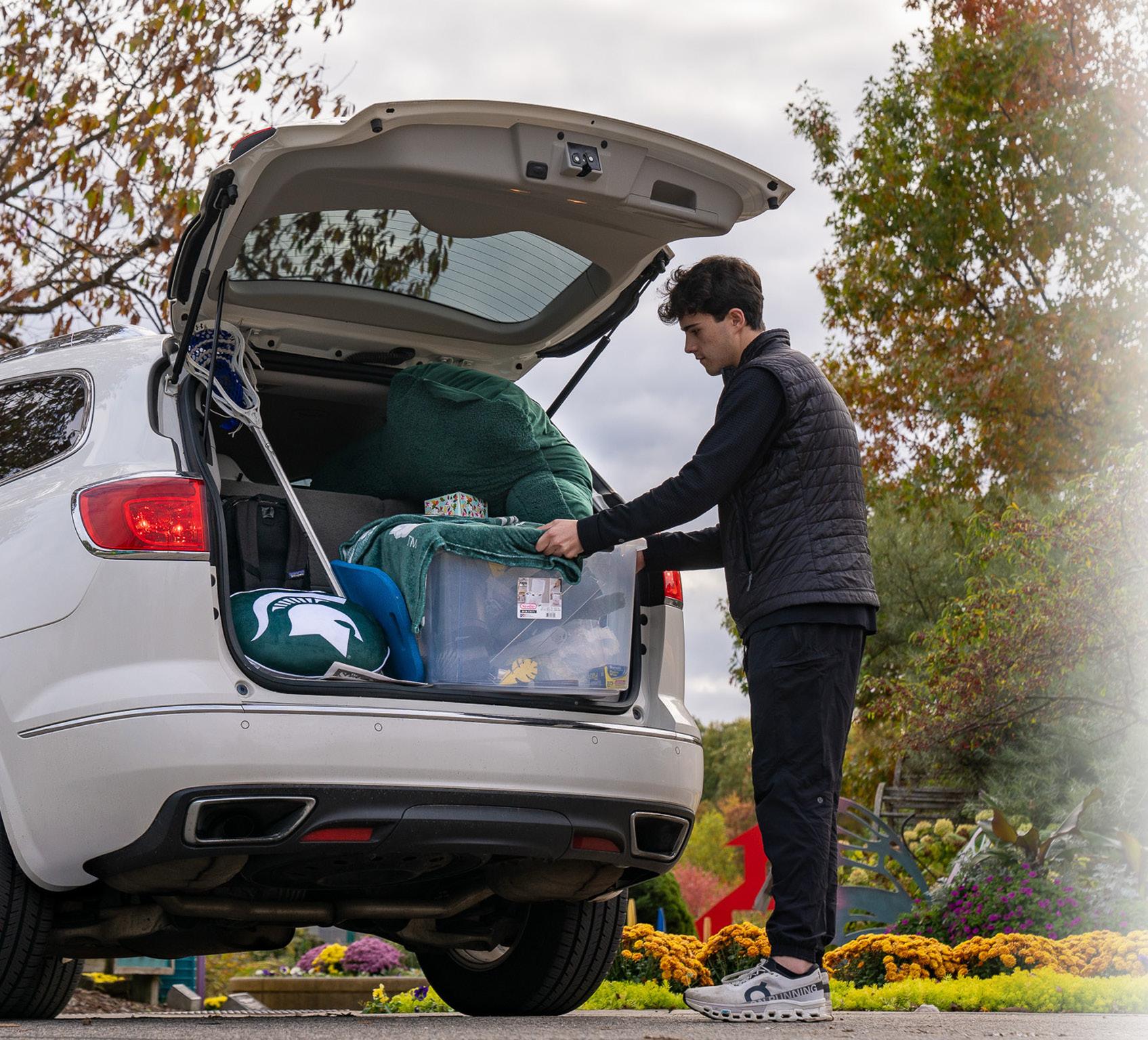
Student-run startup keeps Spartans on the move
What started as one student lending his car to friends has grown into RentEL, a campus-born car rental service helping Spartans find affordable rides on and off campus.
PAGE 5
The off-campus housing struggle
At Michigan State University, first and second-year students, with some exceptions, are required to live in on-campus housing. However, once that requirement has been fulfilled, many upperclassmen choose to live off campus in places, like apartments and houses.
PAGE 6
The porch
pirate takeover
As e-commerce has continued to grow in the U.S., so has the threat of package thefts. In East Lansing, students at one apartment building expressed their discontent with their management company’s lack of response to the issue.
PAGE 7

TUESDAY, OCTOBER 28, 2025
EDITORIAL TEAM
The State News is published by the students of Michigan State University every other Tuesday during the academic year. News is updated seven days a week at statenews.com. State News Inc. is a private, nonprofit corporation. Its current 990 tax form is available for review upon request at 435 E. Grand River Ave. during business hours.
One copy of this newspaper is available free of charge to any member of the MSU community. Additional copies available at The State News office for a fee.


SUBTLE RESPONSIBILITIES OF OFF-CAMPUS LIVING CHANGE THE GAME FOR STUDENTS
By Alyssa Perera aperera@statenews.com
When making the move to off-campus housing, rent and location are prioritized, putting cleaning, damages and upkeep on the back burner.
The pressure might be off when leases get signed, but the responsibilities are only beginning. Paying for housing is typically where the similarities between on and offcampus housing end. Without the safety net of campus resources, the need for furniture and groceries arises.
“When you live in a dorm, you really don’t have to worry about anything because it’s all provided for you,” Cedar Greens resident and
that I’m communicating with roommates early enough in advance and everything else, has been a huge responsibility, just like learning how to budget and how to be aware of how much money you’re spending. I was grateful enough that when I was living in the dorms that my parents were paying for it, but since then, I decided that I was going to take on more responsibility and pay for the apartment to kind of lessen the burden. And I feel like it’s really helping me with just responsibility and kind of learning how to survive in the real world, which is what college is all about.”
This juggling routine of new responsibilities, although shocking, can give students a taste of the real world.
“[It’s] defnitely a learning curve,” Julien said.
freaked out and said that I wasn’t gonna go for another three weeks. Just getting into it and realizing how much things cost, and there are certain things like utility bills, you’re going to spend money on, electricity, especially if your oven is electric, which we have. I think it’s just been an adjustment period, but now that I’m into it, I feel like I’ve got a good routine and obviously there are some weeks where I feel like I’m spending so much money compared to others, but I feel like it all balances out in the end.”
Along with the responsibility of budget and other costs, living conditions are put on students’ shoulders as they leave the dorm nests.
“There is defnitely a difference in upkeep,” Landings at Chandler Crossings resident and journalism sophomore Allison Sheets said. “I think the level of comfort with that varies from person to person. I’m a very clean person, so being able to vacuum and clean my whole bathroom like every four days, that’s what makes me feel good. As for me and my personal space, I fnd it very easy to maintain. The shared spaces are obviously a different story.”

Kitchens, bathrooms and more can be a completely different ballgame than just sharing a bedroom, which students may already have experience with.
“Especially in the kitchen, it’s just little things that you have to get used to,” Sheets said. “I think I probably wasn’t used to it until, like two weeks ago, that I truly started to settle in. (The kitchen) has been a little bit more tough because it’s all four of us. Sometimes that can get frustrating because it’s like, I would like to use the sink, but both sides are full of dishes. But, I think those are the situations where you have to come at it with a lot of grace, where it’s like, we’re all just college kids and we’re busy and things are going to get hectic and somebody’s going to forget to do the dishes for a while and maybe just send them a text and be like, ‘Hey man, can you do the dishes at some point?’ And then it’ll all get fgured out.”
With more square footage comes more room for error. For Sheets and her roommates, it was a

dye staining the bathrooms, burn marks, stained carpets, carpets smelling of cigarette smoke, missing furniture and more. When maintenance can be less than timely, Sheets took matters into her own hands.
“I’ve had to replace some stuff myself,” Sheets said. “When I moved in, my toilet seat was covered in [dye], and it was so bad and old that my dad visited me, and he was like, ‘Yep, we’re just going to get a new one,’ [and] got a new one for my roommate because her’s had a similar issue. We have been begging to get new carpet, [and] we bought our own barstools because we were missing them when we moved in. We put in a maintenance request like two months ago, saying that we had problems with the carpet, problems with the stove and we were missing furniture, and we still have not heard anything. It’s livable, but it’s not the most comfortable to deal with all the time.”
For 25 East resident and environmental biology junior Kalin Baldwin the upkeep in the apartment is better than it was at home, now that she doesn’t have to take care of three pets.
“It’s defnitely a lot easier here,” Baldwin said. “When I lived at home, I did [the] majority of the cleaning. It’s so much easier, and [cleaing] is something that I don’t really have to worry about like every single day, which is nice. I clean pretty much as I go, I don’t like to let messes form. I’ll do a deep clean about once every two weeks, where I’ll deep clean my bathroom, and I’ll try to vacuum.”
Maintenance was called for a broken washing machine upon move-in and took two weeks to bring the new one. Baldwin was also met with no shower rod, no window screen and closet doors that had fallen off.
In response to the issues, Baldwin and her roommate bought their own shower rods, she propped the closet doors up on her wall and doesn’t open her window.
“It’s been pretty good, I feel like I’ve been able to keep up with everything,” Baldwin said. “I’m really only here during the week. I go home pretty much every weekend, so I’m only here four days a week anyway.”




Student-Run Startup RentEL Keeps Spartans on the Move
By Alana Lundgaard alundgaard@statenews.com
When Michigan State finance sophomore Soham Sampat noticed how often his friends struggled to fnd affordable rides, he decided to help the best way he could: by lending out his own car.
What began as a simple favor soon turned into an idea that kept growing. Today, that idea is RentEL, a student-run car rental service with a feet of ten vehicles and more than 200 students who have used it to get where they need to go.
During his freshman year, Sampat’s car became the unoffcial ride service for his dorm foor. Someone needed a lift or asked to borrow his keys so frequently that it made him realize how few options students had when they wanted to get off campus.
“Either you take the bus, you walk, which is really inconvenient, or you can do a Zipcar, which is like 28 bucks an hour, plus a young driver fee, which is ridiculous for someone our age,” Sampat said.
That’s when he saw an opportunity. He started small, renting out his own car for $50 to $60 a day, but the demand rapidly grew to the point where he could hardly use his own vehicle anymore. The side hustle to help friends became a business worth building.
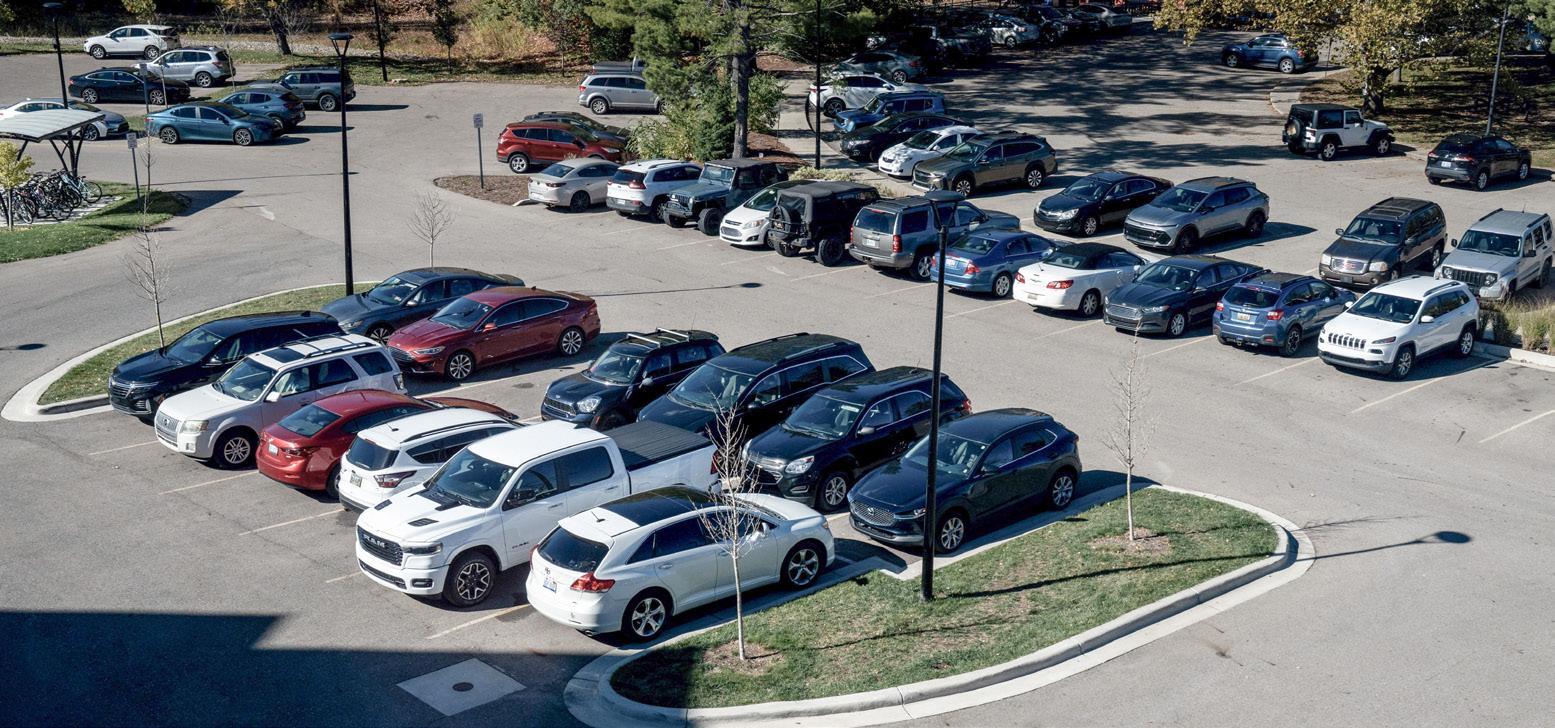
As the requests kept coming, Sampat reinvested what he earned. He used the profts from those frst rentals to buy another car, then applied for a low-interest loan through MSU Federal Credit Union.
“From there, I was able to buy three more cars,” Sampat said. “And with that money, it eventually fipped into a total of 10 and that’s where we’re at right now.”
As RentEL grew, so did the challenges. Sampat said the hardest part wasn’t managing the cars, it was earning people’s trust.
“Nobody knew me here, and I didn’t know anyone either,” Sampat said. “So I had to be reliable. I had to take care of the maintenance

and learn how to fx all these cars myself, because if you go out in Lansing and pay a repair shop, you’re not going to make any money at all.”
He taught himself how to replace brakes, rotors and motors, often working late in parking lots under the hood. Sometimes, he’d even get a call in the middle of the night from a stranded renter and rush to help.
“I’ve had to leave my house at three in the morning to fx a fat tire because it burst on the highway,” he said. “I just wanted to make sure my customers had a good experience.”
That hands-on experience taught him more than any textbook could. Still, Sampat credits his early business classes in high school and at
MSU for giving him the foundation to manage RentEL’s growth.
“I’ve learned a lot from every sector,” he said. “It’s helped me put everything together.”
As the business gained traction, Sampat began thinking about how to reach students beyond his dorm. That’s when he turned to social media.
“When I got here, I found out about the MSU 28 and MSU 29 stories on Snapchat,” he said. “I posted on there and started getting DMs from people saying I should go advertise on campus. People were actually trying to help me out.”
Taking their advice, Sampat printed QR codes that linked directly to his website, and hung them anywhere students might notice. He placed them at bus stops, near CATA stations, and on light poles across campus.
“People would walk by in the mornings and scan them on their way to class,” he said. “I would get thousands of views every single day.”
For Sampat, the experience showed how much support student entrepreneurs can fnd within the MSU community. “People here really helped me come up with that idea,” he said.
Looking ahead, Sampat plans to expand his business to other areas and universities, including Ann Arbor and his hometown, Chicago. What began with a single set of car keys has grown into a business that drives students toward independence, one ride at a time.
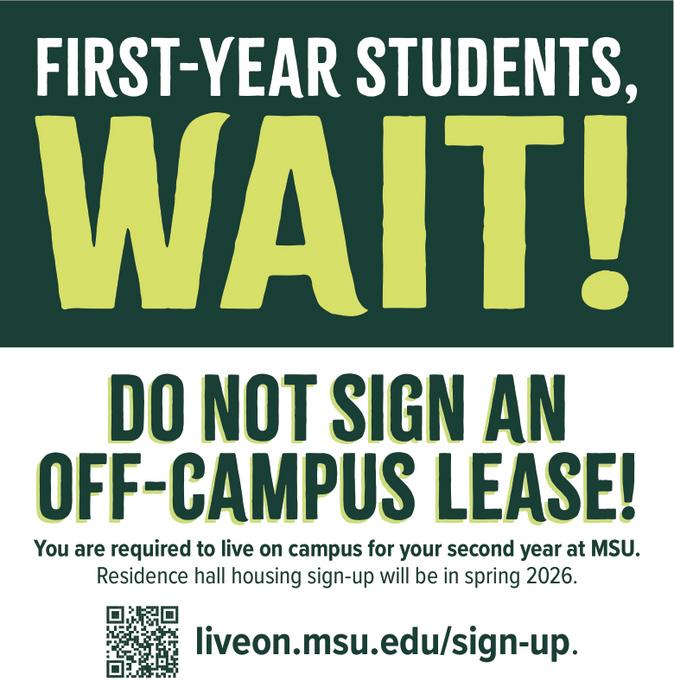
HOW DO MSU STUDENTS SELECT OFF-CAMPUS HOUSING?
By Amy Cho acho@statenews.com
At Michigan State University, frst and secondyear students, with some exceptions, are required to live in on-campus housing.
However, once that requirement has been fulflled, many upperclassmen choose to live off-campus in apartments and houses that surround MSU.
Students typically start to look for future housing during the fall semester, a year prior to when they would be moving in. Students often request tours and look at company websites to help decide.
For math secondary education junior and Red Cedar Flats resident Izzy Cyncewicz, the process of fnding off-campus housing was tough.
“It was kind of like stressful, to be honest, because, like, everything has to get done in like early October if you want a good spot for housing,” Cyncewicz said. “So it was kind of stressful on top of classes and all that kind of stuff.”
However, elementary education sophomore and University Edge resident Grace Malenfant said the process wasn’t diffcult for her.
“Selecting off-campus housing was fun,” Malenfant said. “We have four people that are living with us, so we had to fnd an apartment that was for four people, but it was fun looking and touring all the apartments.”
With the neighboring areas of MSU’s campus offering many off-campus housing options, students often have to consider the pros and cons of each property.
For economics senior and The Hub resident Artur Magalhaes, location was “one of the biggest reasons” he chose the apartment complex.
Before living in The Hub, which is located in downtown East Lansing on Grand River, Magalhaes had lived in a house on Stoddard Avenue, east of campus, but decided to move to a more central location.
“I’m doing economics, so a lot of my classes
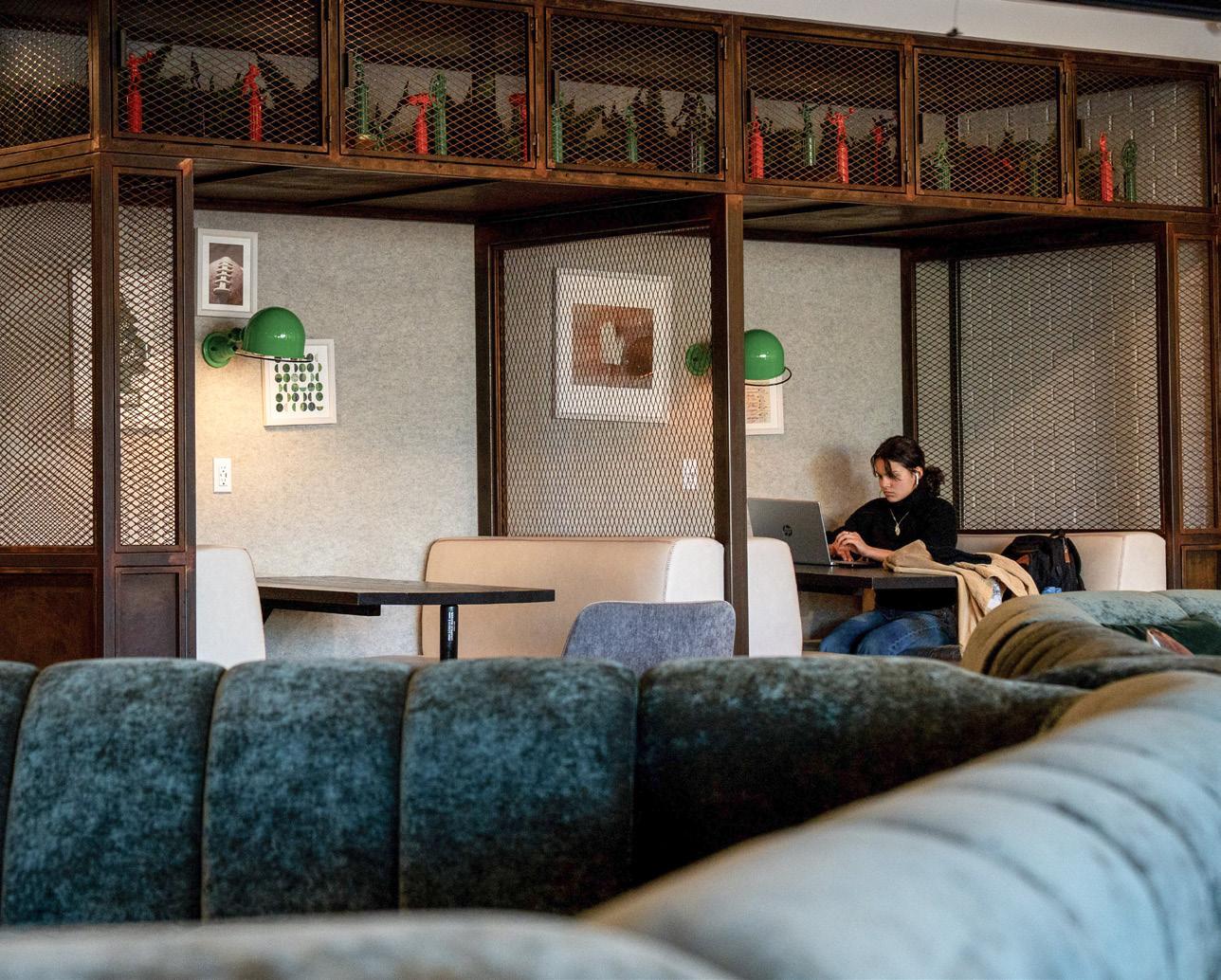
are close by to this side, and I also really like living in [this] part of the city, being so close to Grand River,” Magalhaes said. “So here’s the perfect spot, because it’s the closest you can get to campus and close to my classes, but also on Grand River, where I can get, like, the bus number one and go downtown or go to the supermarkets. It is accessible anywhere by bus or walking.”
For Cyncewicz, they were drawn to living at Red Cedar Flats, which is located near Okemos and just a short walk from MSU’s East Neighborhood, due to its proximity to campus.
“When I didn’t think I was gonna have a car, I needed something that was close so that I could walk to campus,” Cyncewicz said. “So fnding something that was this close to campus, that’s like a 30-minute walk from, like, central campus, was super nice for me because it was way more convenient for like me to be able to get to campus pretty easily without having to drive.”
Similarly for Malenfant, the location of University Edge, which is in Lansing and near Brody Neighborhood, was a factor in deciding to live there.
“... It’s a good location to the football and basketball games, and it’s just close to campus.” Additionally, each housing option may provide amenities that potential residents could be interested in.
At The Hub, Magalhaes said he likes the ample amount of spaces for him and his friends to gather.
“I feel like people here are very social in general, like people are nice. You can talk to anyone, and everyone is responsive,” Magalhaes said. “They have a nice space to play pool and hang out with friends. They have space for you to, like, build small gatherings and to study.”
At Red Cedar Flats, Cyncewicz said the in-unit washer and dryer was an amenity that helped them choose their current apartment.
“That’s really nice because I was living in Abbot [Hall] my freshman year and … the
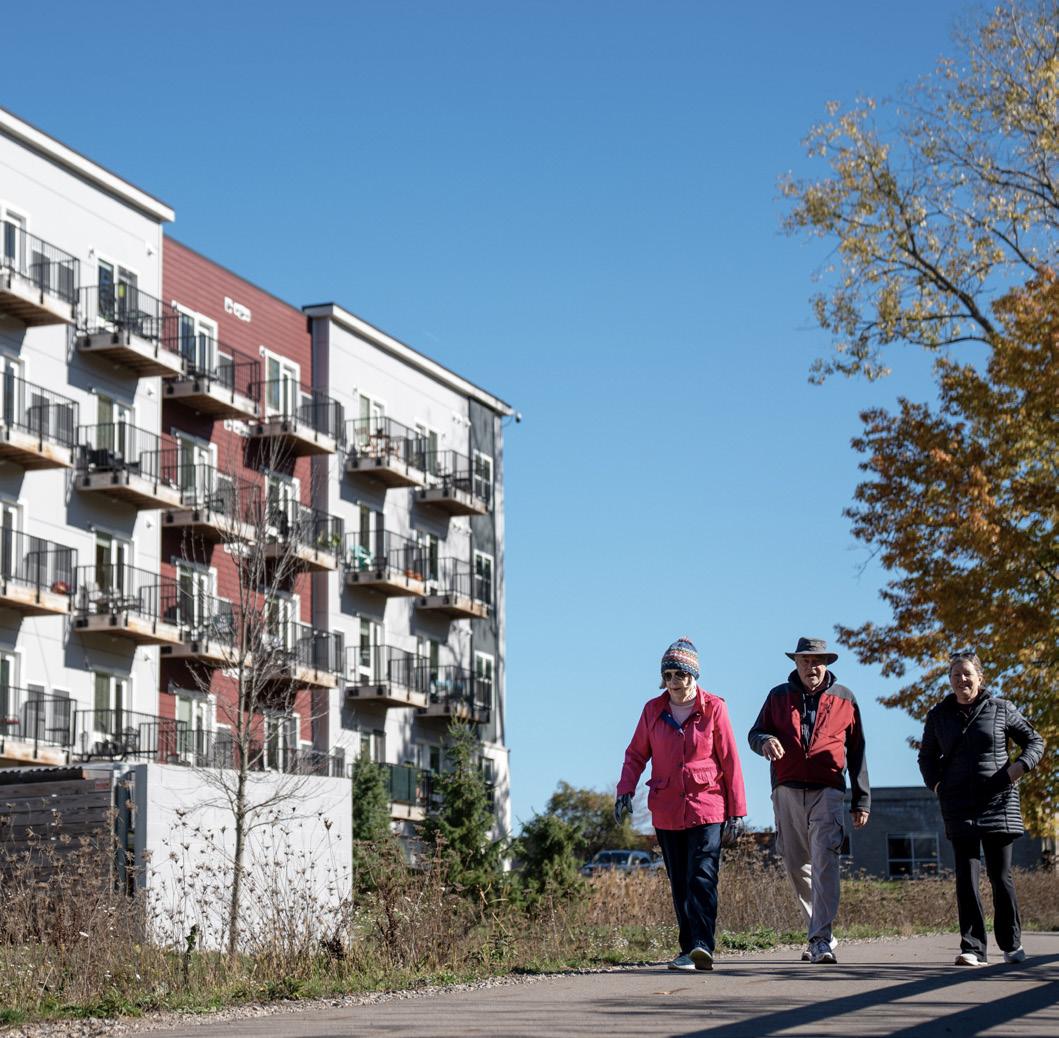
washer [and] dryer were all in the basement, and so it was like, climbing downstairs every single time I want to do laundry, then climbing back up the stairs and everything,” Cyncewicz said. Additionally, at University Edge, a variety of stores and restaurants are nestled right underneath.
Although Malenfant herself doesn’t shop at these stores, her friends enjoy having places to shop that are conveniently located.
“Students typically start to look for future housing during the fall semester, a year prior to when they would be moving in,” Cho said. “Students often request tours and look at company websites to help decide.”
Amy Cho State News Reporter
Along with the pros that off-campus housing options offer, some cons may also appear.
Magalhaes said at The Hub, the building doesn’t live up to the price that residents are required to pay.
An elevator constantly broken, high electricity bills, hidden fees and unclean common spaces are some of the cons that Magalhaes said.
“I feel like the advertisement is not fair for what they deliver,” Magalhaes said. “So they have all that they say they have, it is true [and] they are never literally lying, but it would be more misleading...”
Magalhaes also said that he wishes The Hub
would provide better service for its residents.
“I know it’s small things, but I want to stress out that it’s an expensive place around here … But I assume that if I’m paying, like for one of the most expensive places here, it would be a little more organized, because otherwise I could just live cheaper somewhere else,” Magalhaes said. “It’s not as much of a premium service as they promise. There’s always something wrong, there’s always something smelly and there is always trash somewhere.”
At Red Cedar Flats, Cyncewicz said the price may be a concern for some.
“It’s really expensive because it’s so close to campus, which is defnitely not ideal,” Cyncewicz said. “I’m very fortunate to have family helping me out when it comes to paying my rent and stuff … Obviously, the closer you are to campus, the more expensive it’s gonna be.”
However, besides all of the shortcomings of these housing options, some may believe that the advantages outweigh the disadvantages. Magalhaes said he chose to move to The Hub due to convenience.
“... [Living in the house] was getting [to be] a lot of work, you know, I had to clean the whole house. It’s a bigger space,” Magalhaes said. “Coming to The Hub, it’s more of like, you know, you’re here, you have 7-Eleven now, so if you need any food, emergency food, you [can] just go up to your apartment [and] take your like trash out back, and that’s as much cleaning you have to do, you know, like you can clean more or less, depending on the person, of course, but I mean, in general, it’s much less work.”
For Cyncewicz, responsive staff members at Red Cedar Flats were one of the advantages that helped them decide to live there.
“I think one of the biggest things is maintenance,” Cyncewicz said. “I know a lot of places [that] are maintained by like, DTN or other companies that notoriously have a lot of issues with maintenance and stuff. In my experience, it has not been like that.”
Renting, roommates and real talk from students on off-campus living

By Lily Cole lcole@statenews.com
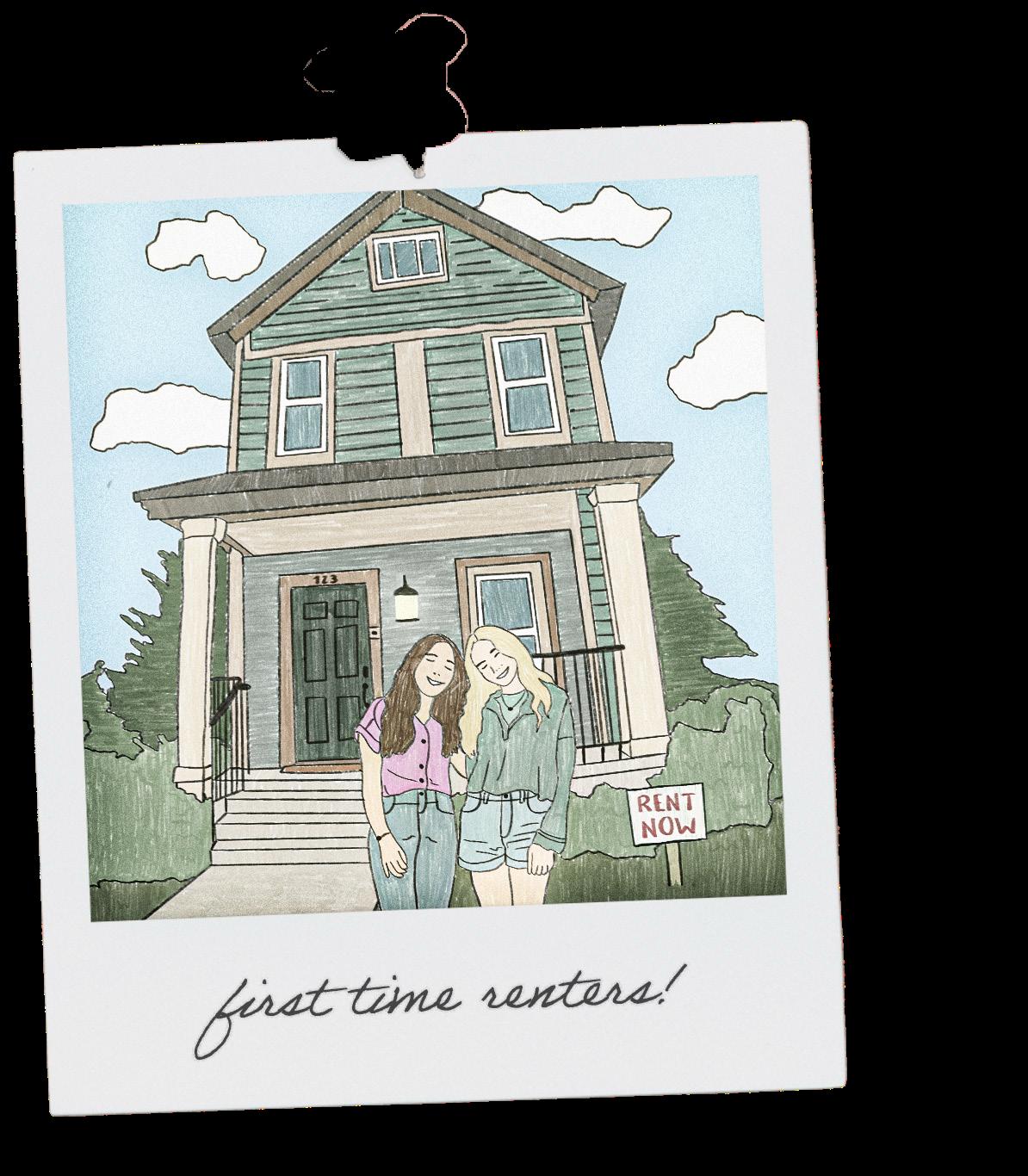
OFF-CAMPUS STUDENTS STRUGGLE WITH “PORCH PIRATES”
By Emilio Perez Ibarguen eibarguen@statenews.com
In early September, Michigan State University students living at the Trowbridge Lofts apartment building decided they’d had enough: something needed to be done about their vanishing packages.
Their presumably stolen goods varied in value and use, ranging from a $10 charging cable to an order of clothes from the online marketplace SHEIN and even favored syrup for making cocktails.
“Too much sh-t stolen,” one student wrote on an informal petition to lock the building’s mailroom taped to the inside of the elevator. “It’s ridiculous.”
At least 58 million packages were reported stolen last year nationwide, according to
For advertising management senior Max Jones, living off campus is just as relaxing as it is stressful.
With roommates who are “the dirtiest people” he’s “ever met,” Jones said to make sure whoever you choose to live with has the same “living values” as you.
“I got so fed up with it,” Jones said. “I went and got one single plate, one spoon, one fork, one bowl, one knife, one pot, one pan, and I just have all my own separate dishes that I wash by hand now.”
Jones lives in a house he rents from his friend’s mom, who bought the property a few years ago. He’s been living there since his junior year. He adds that these “living values” are important for maintaining a good relationship between roommates.
“They’re getting better,” he said. “I like the guys. They’re good people.”
Journalism junior Mikayla Mazza, who lives in the DTN-run apartment complex Cedar Greens, agrees that core values between
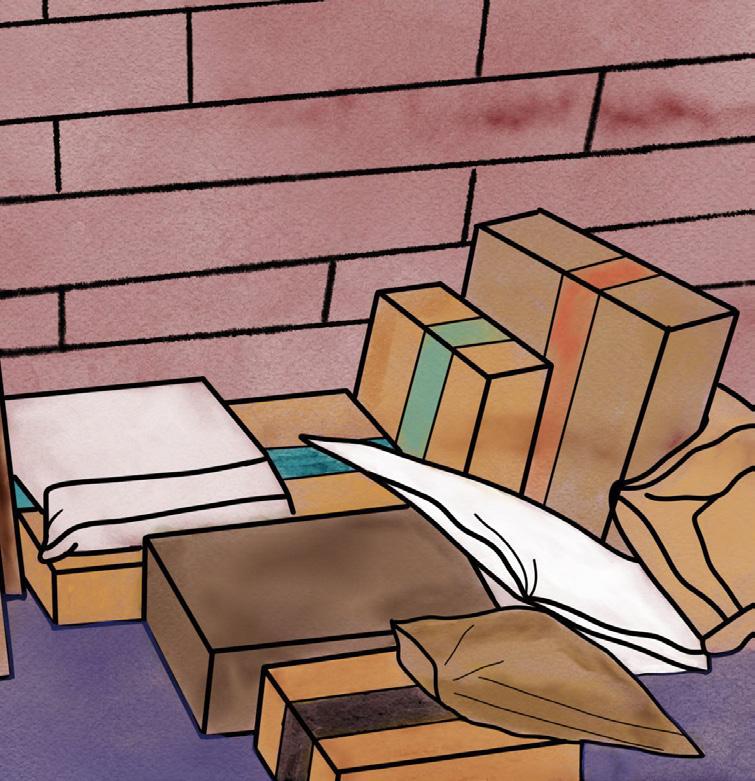
a May report from the U.S. Postal Service. So-called “porch pirates” swiping packages from mailrooms, mailboxes and front doors are responsible, by some high estimates, for $16 billion in annual losses.
The government estimates that up to one-quarter of all Americans have had a package stolen.
While people living in houses can use security devices like Ring doorbells to deter thieves, or request that delivery people leave their packages in inconspicuous spots, the fate of apartment residents’ packages largely depends on how their management company stores deliveries.
Some apartments like the Hub, a high-end complex located just northwest of campus, store all packages in secure lockers that residents can only open with a private PIN. A front desk employee at the apartment said
roommates are important.
“I really think that if you enjoy the people that you live with and really want to further your relationship, then you can work through any kind of small stuff,” Mazza said.
When it comes to beginning your housing journey, starting early is something public relations junior Emiley Visioni suggests. Visioni lives in Block 36, about 15 minutes from campus.
“I think that the most important thing is to research and look at reviews and see what people say,” she said.
Mazza suggests scheduling a day trip to East Lansing to look at possible housing options.
“It’s a competitive market,” Visioni said. “I wish we (her and her roommates) had more options because now we’re fguring out, for next year, if we want to do something else or do the same thing.”
Planning time to drive to campus, or even walking from an apartment complex, is also something to consider when renting.
“The biggest thing is just having to drive to class and fnd a place to park,” Jones said. “You just got to manage your time a little better getting to classes and stuff.”
the lockers essentially eliminate the possibility of package theft.
Package deliveries to the 565 Building, located nearby on Grand River Avenue, are dropped off in its lobby, which is only accessible after punching in a door code. Delivery services like Amazon allow consumers to share door codes with the delivery driver to let them inside.
At Trowbridge Lofts, operated by DTN Management, most packages are placed on a shelf inside the building’s vestibule, which is unlocked at all hours of the day and visible from outside.
Mechanical engineering junior October Marquez is one of the Trowbridge Lofts residents who signed the petition to “change the mailroom system” after one of her packages, an order of socks, was stolen.
Before moving in, Marquez said, a friend warned her to “be careful getting your packages sent here, because she’s had issues with packages being stolen.”
The petition Marquez signed has since been removed from the elevator interior. She said DTN management has not communicated with residents about whether they plan to change how packages are received. In fact, they haven’t acknowledged the petition at all.
“They’re usually pretty slow, honestly, about getting to any kinds of changes,” Marquez said.
DTN Senior Director of Marketing Debbie Balaker did not respond to requests for comment.
Despite deliveries being similarly accessible to anyone, Anna Fisher, an employee at Red Cedar Flats, located east of campus, said “not too many”
Jones said the lot in front of the International Center is usually the one with a few open spots.
As well as living values, Mazza said one of the most important things to always keep in mind is safety.
Mazza and her roommates once found a stranger sitting in their stairwell early in the morning. This happened a few times, and they contacted their complex. When the complex said there was nothing they could do, Mazza said it wasn’t that they felt unsafe, but that they didn’t feel comfortable, and they contacted the non-emergency East Lansing police department.
The experience taught them to trust their instincts and take action when something feels unsafe, such as repairing broken locks or reporting issues to management. Living offcampus, she said, requires self-advocacy to ensure safety needs are met.
“If you keep being persistent and asking again and again for these sorts of things, something will change,” she said. “I mean, it’s an exhausting truth, but that is just the reality of living off campus in a college town.”
packages get stolen from the property.
As for residence halls, for the last 10 years, packages delivered to students living on campus have been received at the front desk. Students are required to present their MSU ID to receive their package.
Spokesperson for Residence Education and Housing Services Bethany Balks said that the system is one reason why so few packages are reported stolen. Last academic year, REHS reported fewer than 10 total packages lost out of 368,000 packages delivered.
One type of delivery that dorms are struggling to process, Balks said, involves newer “lastmile” carriers delivering products from retailers like SHEIN, AliExpress and TEMU. Packages delivered by those carriers often lack the standard tracking labels expected from traditional carriers like UPS or FedEx, leaving residence hall staff unsure whether to accept them.
Balks said residence halls are trying to adapt by setting up tables for alternative carriers to leave packages at, though that system leaves those packages more exposed.
“What we’re fnding is they’re a lot more vulnerable to be misplaced or taken and it’s not something that is through our established channels,” Balks said.
For most students, the delivery process represents one more quality-of-life advantage to living in dorms that supply free meals, streaming subscriptions and are conveniently located. Dealing with the absence of an air-tight package system, it seems, is one more challenge that comes with growing up.
STUDENT LEGAL SERVICES OFFER RESOURCES FOR STUDENTS APPROACHING LEASE AGREEMENTS
By Reiel Ghiglia rghiglia@statenews.com

The State News sat down with Attorney Dave Meyers for an interview to discuss how MSU students can utilize their resources to make their lease agreement as smooth as possible. Made possible by ASMSU’s student tax, Student Legal Services offers services to improve understanding when navigating off-campus housing lease agreements.
Student Legal Services can help students during each phase of their signing process. Before signing, students can consult attorneys about a lease review, which covers major lease terms, helps identify red fags and confrms if expected amenities are explicitly included in the lease. Non-refundable fees can also be reviewed, with attorneys ensuring that students understand the signifcance of each fee and when they can be problematic.
“And certainly, we have knowledge about certain landlords that we’ve had issues with,” Meyers said. “We see most of the issues, so we
During tenancy, students often face a number of challenges, including being stuck in their lease unwillingly, roommate conficts, maintenance/ repair issues and potential eviction. In times of confict between landlords and apartment administration, Student Legal Services offers defense services to negotiate with landlords to reach a potential compromise.
When handling roommate disagreements, which occur from various situations like fnancial issues, unsanitary and unhealthy living conditions, and domestic violence, attorneys can advise students on potential legal avenues for victims to exit a lease.
Upon the completion of a lease, if students face unnecessary fees and holds on security deposits, Student Legal Services are able to intervene, assisting students in disputing larger bills and taking legal action against landlords who don’t follow the security deposit act.
Meyers, despite having hundreds of cases regarding housing, wishes students would utilize the resources that Student Legal Services provide.
website and contacting them to set up a consultation. Student Legal Services will usually ask for proof of student tax payment and a summary of the case prior to appointments.
“It’s not that we’re not being utilized, but at the start of leases, we would like to be doing more lease reviews because we can always come in on a case,” Meyers said, “It’s a lot easier when the students already spoke to us if an issue occurs, they already have some of the tools that will give them to help with the case when they do come in.”
Meyers pointed out common pitfalls students encounter when signing a lease, such as panic signing, neglecting research, settling for verbal agreements, unawareness of non-refundable fees and lease terms, lack of roommate agreements, and misunderstanding lease types. All of these issues that students encounter can negatively impact their experience living off campus.
“Again, sometimes students just think of it as ‘something I can get out of, it’s no big deal if I need to switch or change.’ It’s not. It is
Legal Services, Meyers recommends searching on the internet and using resources like Google reviews to see previous residents’ experiences at the complex. Furthermore, taking tours to see
“Again, sometimes students just think of it as ‘something I can get out of, it’s no big deal if I need to switch or change’. It’s not. It is a legally binding document for a year for a good chunk of money,”
Dave Meyers Attorney, Student Legal Services
how well the property is maintained outside and inside can provide important insights to potential
It’s also important to understand what landlords can and cannot do; the Michigan Truth in Renting Act provides a guideline so students can know their rights and make informed
If students are unsure if a housing issue they are encountering is a legal issue or not, Meyers still encourages students to visit student legal services. “”f it’s not something we do; we’ll help you fnd a resource to help you, but at the very least we can kind of give you some baseline


Popular halloween costume predictions for 2025
By Alyssa Perera aperera@statenews.com
Last year, it was cheetahs and Disney princesses that took over every Halloween party. This year’s most popular costumes are still out for review. However, TikTok may provide a clue to what the biggest trends might be.
2000s fashion has been on an uptick in recent years with a return to items like low rise jeans and babydoll tops. Popular brands like Hollister and Juicy Couture have made throwback collections inspired by the early 2000s earlier this year; it was only a matter of time before Halloween costumes got the memo.
The internet dug into the past for a viral 2000s ladybug costume originally from Leg Avenue, causing many variations of the outft to take the internet by storm. This includes DIY versions that might be more accessible to college students.
“That one costume that everyone’s wearing, we’re not wearing that exact one,” packaging sophomore Hannah Sanderson said. “I’m not sure what I’m actually wearing yet because I have a tank top and I was thinking of wearing like a jacket over it. I like ordered like a red dress with like black spots because like that would work. I’ll just, like, wing it on the night of.”
To compliment this, a 2000s bumblebee costume also returned from the dead. Exploratory preference freshman Emma Wilkinson is going the DIY route for her costume with a yellow shirt, antennae, wings and socks she bought from Amazon and a black skirt that she already owned.
“I was the one that kind of mentioned it, but I saw [the bumblebee costume] on TikTok, and this was well before the Halloween season
before it got popular,” Wilkinson said. “It’s my frst Halloween at college and like, I’m broke, so I wanted, like something easy to put together and I know that it’s a popular costume and it’ll be really easy for people to realize.”
It was Wilkinson who hoped to be a bumblebee and frst suggested the costumes to Sanderson.
“Hannah and I just met this year so we both hit it off really well,” Wilkinson said. “We’re both in the marching band together. We just connected really fast and it’s important to make connections while you’re at college, so I was like, ‘Oh, perfect, I got a person to do Halloween with.’”
Wilkinson and Sanderson then asked their friends whose personality would ft each of the costumes and settled on Sanderson as the ladybug and Wilkinson as the bumblebee.
“I think especially if we’re together, they’ll know, like, that’s a ladybug and that’s a bumblebee,” Wilkinson said. “There’s like the old Leg Avenue popular costumes from like the 2000s that I know people are fnding them everywhere, but we just did the DIY.”
“People might be wearing like the one ladybug costume,” Sanderson said. “I think they’ll know and there might be other people [wearing them], I’m not sure. If they are the same thing, I don’t think they’ll be the exact same just because like we didn’t buy like a costume, we bought like different things.”
Another viral costume is the bird Blu from the 2011 movie, Rio. The costume trend started out small last year but is fully taking fight this year with the song that goes with it on TikTok currently having 250K videos.
“I saw it kind of like start to become trending and I love the Rio movie, that was my childhood,”


biosystems engineering junior Sierra Moore said. “I love that movie so much, so when I saw it, I was kind of like, ‘I have to do it.’ It’s really cute, I like the sparkles and everything, too, with the costume.”
Moore will be one of four “Rio” birds with her friends on Halloween. She will be the character Blu while her friends will be red, pink and purple variations of the costume.
“I had the idea of it, I wanted to do it, and they were kind of like, ‘Oh, that’s cute let’s do it like the same day together,’ I was like, ‘Yeah, of course,’” Moore said. “I think everyone will kind of know what it is because it’s, like trending right now and I feel like with the wings and everything, I feel like it, like, kind of pulls it together and makes it, like, noticeable.”






